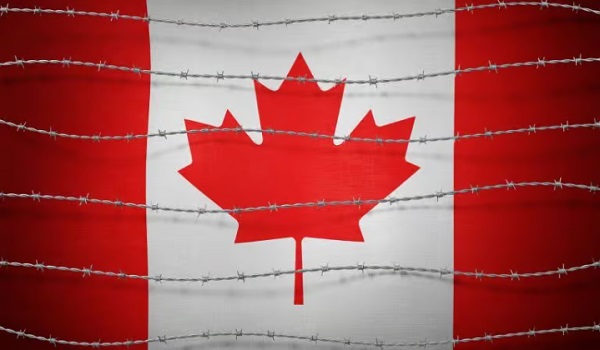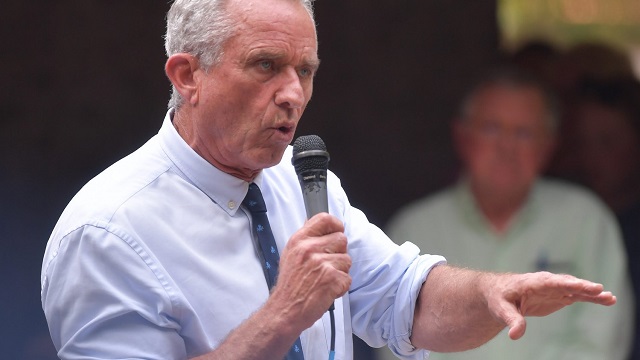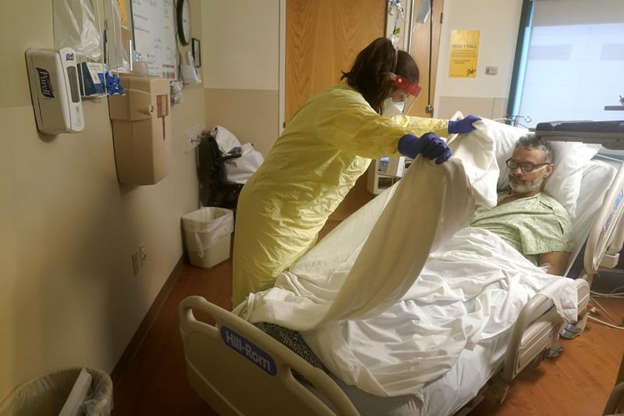Brownstone Institute
Freedumb, You Say?

From the Brownstone Institute
By
“Authorities have attacked, detained, prosecuted, and in some cases killed critics, broken up peaceful protests, closed media outlets, and enacted vague laws criminalizing speech that they claim threatens public health”
Didn’t give much thought to freedom until four years ago, at age 63. Freedom was just there, like the water surrounding a goldfish. And then the Covid-19 pandemic blew in, the world locked down, and admonitions to “stay the ‘$^#&’ home” blazed through social media. No freedom was too important to discard in the name of public safety: jobs, family businesses, artistic endeavours, public meetings, social connections that kept despair at bay, all took a backseat to the grim business of saving grandma (who ended up getting Covid anyway). No discussion of moral or practical trade-offs, no pushback from the press, nothing. It felt wrong to me on a cellular level.
Apparently I was the only one in my middle-class liberal circle to harbour misgivings about this astonishing new world. If I tried, ever so timidly, to articulate my concerns on Facebook or Twitter, the online warriors shot back with a string of epithets. “Go lick a pole and catch the virus,” said one. “Crawl back into your cave, troglodyte,” said another. And my all-time favourite: “You’re nothing but a mouth-breathing Trumptard.”
From the get-go, I perceived Covid as more of a philosophical problem than a scientific one. As I wrote on more than one occasion, science can inform our decisions, but not dictate them. What ultimately powers our choices are the values we hold. I saw Covid as a morality play, with freedom and safety cast as the duelling protagonists, and it looked like safety was skipping to an easy victory.
It was a heady time for the health bureaucrats, whose increasingly arcane rules betrayed a naked impulse to control: the Canadian high-school students required to use masks on both their faces and their wind instruments during band practice, the schoolchildren forced (for hygiene reasons) to study on their knees for hours in an Alaska classroom, the “glory-hole” sex advised by the British Columbia Centre for Disease Control. The lack of public pushback against these absurdities heightened my awareness of the fragility of our freedoms.
One of the earliest memes to surface during the pandemic was “muh freedumb.” The locution became a shorthand for a stock character – a tattooed man wearing camo gear and a baseball cap, spewing viral particles while yelling about his rights. A selfish idiot. The memes kept coming: “Warning, cliff ahead: keep driving, freedom fighter.” “Personal freedom is the preoccupation of adult children.” Freedom, for centuries an aspiration of democratic societies, turned into a laughing stock.
Eventually, pro-freedom voices began trickling into the public arena. I wasn’t alone, after all. There were others who understood, in the words of Telegraph writer Janet Daley, that the institutional response to Covid-19 had steamrolled over “the dimension of human experience which gives meaning and value to private life.” Lionel Shriver decried how “across the Western world, freedoms that citizens took for granted seven months ago have been revoked at a stroke.” And Laura Dodsworth brought tears to my eyes when she wrote, in her 2021 book A State of Fear, that she feared authoritarianism more than death.
Once the vaccines rolled out, the war on freedom of conscience went nuclear. If you breathed a word against the products, or even the mandates, you were “literally killing people.” The hostility towards the “unvaxxed” culminated in a Toronto Star front page showcasing public vitriol, splashed with such sentiments as: “I honestly don’t care if they die from Covid. Not even a little bit.”
This, too, felt viscerally wrong. I knew several people who had refused the vaccine, and they all had well-articulated reasons for their stance. If they didn’t fully trust the “safe and effective” bromide recycled by all government and pharmaceutical industry spokespeople, I could hardly blame them. (And I say this as someone who writes for Big Pharma and got five Covid shots.)
One of the most deplorable casualties of Covid culture was freedom of expression, a core principle in the United Nations’ Universal Declaration of Human Rights. Experts speaking publicly about the harms of lockdown faced systematic ostracism from mainstream media, especially left-wing news outlets. By early 2021, Human Rights Watch estimated that at least 83 governments worldwide had used the Covid-19 pandemic to violate the lawful exercise of free speech and peaceful assembly.
“Authorities have attacked, detained, prosecuted, and in some cases killed critics, broken up peaceful protests, closed media outlets, and enacted vague laws criminalizing speech that they claim threatens public health,” the group wrote in a media release. “The victims include journalists, activists, healthcare workers, political opposition groups, and others who have criticized government responses to the coronavirus.”
But what about misinformation? Doesn’t it kill people? Newsflash: misinformation has always existed, even before TikTok. It’s up to each of us to sift the credible folks from the cranks. The best defence against misinformation is better information, and it’s the policy wonks’ job to provide it. Modern science itself depends on this tug-of-war of ideas, which filters out weaker hypotheses and moves stronger ones ahead for further testing.
Besides, misinformation comes not just from cranks, but from “official sources” – especially those tasked with persuading the public, rather than informing it. Remember when Rochelle Walensky, former director of the Centers for Disease Control and Prevention in the US, asserted that “vaccinated people do not carry the virus?” Or when Anthony Fauci maintained that getting vaccinated makes you a “dead end” in the chain of transmission? I rest my case.
The marketplace of ideas is like a souk, with a lot of hollering and arguing and the odd snatched purse – and that’s exactly how it should be. It’s an ingenious and irreplaceable process for getting to the truth. There are few ideas too sacrosanct to question or too ridiculous to consider. That’s why, unlike just about everyone in my left-leaning circle, I take no issue with Elon Musk’s shakedown of the old Twitter, now the Wild West of X.
Under Musk’s algorithms, my feed has become a true philosophical souk, with wildly disparate views smashing into each other, leaving me to sift through the rubble in search of a gold nugget or two. Love him or hate him, Musk offers a much-needed counterweight to the ideological lockstep in much of the mainstream media. And when it comes to free speech, Musk has put his money where his mouth is: when media personality Keith Olbermann recently hopped on X, where he boasts a million followers, to call for Musk’s arrest and detainment, Musk made no move to censor him. Works for me.
While the “old normal” has thankfully returned to our daily lives, save the odd mask in a shopping mall or subway car, the stench of censorship that blew in with the pandemic has yet to dissipate. An obsession with disinformation permeates the zeitgeist, spurring lawmakers in several Western countries to censor the flow of thoughts and ideas that gives a free society its pulse.
We cannot excise personal freedom from a democratic society, even in the interests of the “public good,” without poisoning the roots of democracy itself. Article 3 of UNESCO’s 2005 Universal Declaration of Bioethics and Human Rights states this plainly: “The interests and welfare of the individual should have priority over the sole interest of science or society.” In our post-pandemic reality, the statement seems almost quaint. Nonetheless, it expresses an enduring truth: that a democracy must never discard the idea of freedom – even in a pandemic.
Freedom desperately needs a comeback from its current incarnation as an expendable frill. In my own small way I’m trying to make this happen: never much of an activist before Covid, I’m now part of a small group preparing to launch a Free Speech Union in Canada, modelled after the highly successful one in the UK. The organisation will offer legal advice to individuals facing censorship, cancellation, or job loss because of their words. I look forward to supporting people caught in this anti-freedom web, including those whose words I heartily disagree with.
My newfound respect for free speech is also what propels me to keep talking about Covid. The response to the pandemic exceeded the bounds of public health, and we need to expose the forces that drove it. Here’s Daley again: “The world went crazy. There is no other way to account for what was an almost nihilistic dismantling not just of particular liberties and rights, but of the very idea of liberty.” We can’t let it happen again.
Republished from Perspective Media
Brownstone Institute
If the President in the White House can’t make changes, who’s in charge?

From the Brownstone Institute
By
Who Controls the Administrative State?
President Trump on March 20, 2025, ordered the following: “The Secretary of Education shall, to the maximum extent appropriate and permitted by law, take all necessary steps to facilitate the closure of the Department of Education.”
That is interesting language: to “take all necessary steps to facilitate the closure” is not the same as closing it. And what is “permitted by law” is precisely what is in dispute.
It is meant to feel like abolition, and the media reported it as such, but it is not even close. This is not Trump’s fault. The supposed authoritarian has his hands tied in many directions, even over agencies he supposedly controls, the actions of which he must ultimately bear responsibility.
The Department of Education is an executive agency, created by Congress in 1979. Trump wants it gone forever. So do his voters. Can he do that? No but can he destaff the place and scatter its functions? No one knows for sure. Who decides? Presumably the highest court, eventually.
How this is decided – whether the president is actually in charge or really just a symbolic figure like the King of Sweden – affects not just this one destructive agency but hundreds more. Indeed, the fate of the whole of freedom and functioning of constitutional republics may depend on the answer.
All burning questions of politics today turn on who or what is in charge of the administrative state. No one knows the answer and this is for a reason. The main functioning of the modern state falls to a beast that does not exist in the Constitution.
The public mind has never had great love for bureaucracies. Consistent with Max Weber’s worry, they have put society in an impenetrable “iron cage” built of bloodless rationalism, needling edicts, corporatist corruption, and never-ending empire-building checked by neither budgetary restraint nor plebiscite.
Today’s full consciousness of the authority and ubiquity of the administrative state is rather new. The term itself is a mouthful and doesn’t come close to describing the breadth and depth of the problem, including its root systems and retail branches. The new awareness is that neither the people nor their elected representatives are really in charge of the regime under which we live, which betrays the whole political promise of the Enlightenment.
This dawning awareness is probably 100 years late. The machinery of what is popularly known as the “deep state” – I’ve argued there are deep, middle, and shallow layers – has been growing in the US since the inception of the civil service in 1883 and thoroughly entrenched over two world wars and countless crises at home and abroad.
The edifice of compulsion and control is indescribably huge. No one can agree precisely on how many agencies there are or how many people work for them, much less how many institutions and individuals work on contract for them, either directly or indirectly. And that is just the public face; the subterranean branch is far more elusive.
The revolt against them all came with the Covid controls, when everyone was surrounded on all sides by forces outside our purview and about which the politicians knew not much at all. Then those same institutional forces appear to be involved in overturning the rule of a very popular politician whom they tried to stop from gaining a second term.
The combination of this series of outrages – what Jefferson in his Declaration called “a long train of abuses and usurpations, pursuing invariably the same Object” – has led to a torrent of awareness. This has translated into political action.
A distinguishing mark of Trump’s second term has been an optically concerted effort, at least initially, to take control of and then curb administrative state power, more so than any executive in living memory. At every step in these efforts, there has been some barrier, even many on all sides.
There are at least 100 legal challenges making their way through courts. District judges are striking down Trump’s ability to fire workers, redirect funding, curb responsibilities, and otherwise change the way they do business.
Even the signature early achievement of DOGE – the shuttering of USAID – has been stopped by a judge with an attempt to reverse it. A judge has even dared tell the Trump administration who it can and cannot hire at USAID.
Not a day goes by when the New York Times does not manufacture some maudlin defense of the put-upon minions of the tax-funded managerial class. In this worldview, the agencies are always right, whereas any elected or appointed person seeking to rein them in or terminate them is attacking the public interest.
After all, as it turns out, legacy media and the administrative state have worked together for at least a century to cobble together what was conventionally called “the news.” Where would the NYT or the whole legacy media otherwise be?
So ferocious has been the pushback against even the paltry successes and often cosmetic reforms of MAGA/MAHA/DOGE that vigilantes have engaged in terrorism against Teslas and their owners. Not even returning astronauts from being “lost in space” has redeemed Elon Musk from the wrath of the ruling class. Hating him and his companies is the “new thing” for NPCs, on a long list that began with masks, shots, supporting Ukraine, and surgical rights for gender dysphoria.
What is really at stake, more so than any issue in American life (and this applies to states around the world) – far more than any ideological battles over left and right, red and blue, or race and class – is the status, power, and security of the administrative state itself and all its works.
We claim to support democracy yet all the while, empires of command-and-control have arisen among us. The victims have only one mechanism available to fight back: the vote. Can that work? We do not yet know. This question will likely be decided by the highest court.
All of which is awkward. It is impossible to get around this US government organizational chart. All but a handful of agencies live under the category of the executive branch. Article 2, Section 1, says: “The executive Power shall be vested in a President of the United States of America.”

Does the president control the whole of the executive branch in a meaningful way? One would think so. It’s impossible to understand how it could be otherwise. The chief executive is…the chief executive. He is held responsible for what these agencies do – we certainly blasted away at the Trump administration in the first term for everything that happened under his watch. In that case, and if the buck really does stop at the Oval Office desk, the president must have some modicum of control beyond the ability to tag a marionette to get the best parking spot at the agency.
What is the alternative to presidential oversight and management of the agencies listed in this branch of government? They run themselves? That claim means nothing in practice.
For an agency to be deemed “independent” turns out to mean codependency with the industries regulated, subsidized, penalized, or otherwise impacted by its operations. HUD does housing development, FDA does pharmaceuticals, DOA does farming, DOL does unions, DOE does oil and turbines, DOD does tanks and bombs, FAA does airlines, and so on It goes forever.
That’s what “independence” means in practice: total acquiescence to industrial cartels, trade groups, and behind-the-scenes systems of payola, blackmail, and graft, while the powerless among the people live with the results. This much we have learned and cannot unlearn.
That is precisely the problem that cries out for a solution. The solution of elections seems reasonable only if the people we elected actually have the authority over the thing they seek to reform.
There are criticisms of the idea of executive control of executive agencies, which is really nothing other than the system the Founders established.
First, conceding more power to the president raises fears that he will behave like a dictator, a fear that is legitimate. Partisan supporters of Trump won’t be happy when the precedent is cited to reverse Trump’s political priorities and the agencies turn on red-state voters in revenge.
That problem is solved by dismantling agency power itself, which, interestingly, is mostly what Trump’s executive orders have sought to achieve and which the courts and media have worked to stop.
Second, one worries about the return of the “spoils system,” the supposedly corrupt system by which the president hands out favors to friends in the form of emoluments, a practice the establishment of the civil service was supposed to stop.
In reality, the new system of the early 20th century fixed nothing but only added another layer, a permanent ruling class to participate more fully in a new type of spoils system that operated now under the cloak of science and efficiency.
Honestly, can we really compare the petty thievery of Tammany Hall to the global depredations of USAID?
Third, it is said that presidential control of agencies threatens to erode checks and balances. The obvious response is the organizational chart above. That happened long ago as Congress created and funded agency after agency from the Wilson to the Biden administration, all under executive control.
Congress perhaps wanted the administrative state to be an unannounced and unaccountable fourth branch, but nothing in the founding documents created or imagined such a thing.
If you are worried about being dominated and destroyed by a ravenous beast, the best approach is not to adopt one, feed it to adulthood, train it to attack and eat people, and then unleash it.
The Covid years taught us to fear the power of the agencies and those who control them not just nationally but globally. The question now is two-fold: what can be done about it and how to get from here to there?
Trump’s executive order on the Department of Education illustrates the point precisely. His administration is so uncertain of what it does and can control, even of agencies that are wholly executive agencies, listed clearly under the heading of executive agencies, that it has to dodge and weave practical and legal barriers and land mines, even in its own supposed executive pronouncements, even to urge what might amount to be minor reforms.
Whoever is in charge of such a system, it is clearly not the people.
Brownstone Institute
Hysteria over Robert F. Kennedy Jr.’s Promise to Make Vaccines Safer

From the Brownstone Institute
By
“People are reacting because they hear things about me that aren’t true, characterizations of things I have said that are simply not true. When they hear what I have to say, actually, about vaccines, everybody supports it.”
Robert F. Kennedy, Jr. has been confirmed as Secretary of the US Department of Health and Human Services.
Within hours, my news feed was populated with angsty articles hand-wringing about the future of vaccines under Kennedy, whom legacy media and the establishment are certain would confiscate life-saving vaccine programs, raising the spectre of mass waves of illness and death.
In particular, this quote from Senator Mitch McConnell (R-KY), the only Republican who voted against Kennedy’s confirmation, appeared over and over again:
“I’m a survivor of childhood polio. In my lifetime, I’ve watched vaccines save millions of lives from devastating diseases across America and around the world. I will not condone the re-litigation of proven cures, and neither will millions of Americans who credit their survival and quality of life to scientific miracles.”
Yet, I could not find one piece of mainstream coverage of this quote that mentioned the astonishing fact that 98% of polio cases in 2023, the most recent year for which we have full data, were caused by the polio vaccine.
You read that correctly. In 2023, 12 wild polio cases were recorded (six in Afghanistan, six in Pakistan), with a further 524 circulating vaccine-derived cases, mostly throughout Africa. This trend is in keeping with data from the previous several years.
An important contextualising detail, wouldn’t you think?

The cause of this polio resurgence is that the world’s poor are given the oral polio vaccine (OPV), which contains a weakened virus that can replicate in the gut and spread in feces, causing vaccine-derived outbreaks.
People in rich countries get the inactivated polio vaccine (IPV), which does not contain live virus and therefore does not carry the risk of spreading the very disease it’s vaccinating against.
The World Health Organization (WHO) and vaccine-promoting organisations say that the way out of the problem is to vaccinate harder, as the argument goes that outbreaks only occur in under-vaccinated communities.
This may be well and good, but the total omission of the fact from media coverage that the goalposts have shifted from eradicating wild polio (not yet complete but nearly there, according to the WHO) to eradicating vaccine-derived polio (the main problem these days) underscores that this is why hardly anyone who knows anything trusts the media anymore.
A member of my extended family has polio. It’s nasty and life-altering and I wouldn’t wish it on anyone.
That’s why I would hope that any vaccines given would be safe – contracting polio from the supposedly preventative vaccine is the worst-case scenario, second only to death.
This is Kennedy’s expressly stated aim.
“When people actually hear what I think about vaccines, which is common sense, which is vaccines should be tested, they should be safe, everyone should have informed consent,” he said at his confirmation press conference.
“People are reacting because they hear things about me that aren’t true, characterisations of things I have said that are simply not true.
“When they hear what I have to say, actually, about vaccines, everybody supports it.”
Grown-ups who support vaccines can walk and chew gum. From the point of view of the public health establishment, the polio vaccine has prevented millions of cases and has nearly eradicated the disease.
At the same time, the world’s poorest are afflicted with polio outbreaks which we can work to prevent, and the safety of all polio vaccine products on the market should be subject to the rigorous standards applied to all other medicines.
Unless you think that poor people don’t matter, in which case the status quo might suit you fine.
Republished from the author’s Substack
-

 International1 day ago
International1 day agoPope Francis has died aged 88
-

 International22 hours ago
International22 hours agoJD Vance was one of the last people to meet Pope Francis
-

 International1 day ago
International1 day agoPope Francis Dies on Day after Easter
-

 2025 Federal Election12 hours ago
2025 Federal Election12 hours agoOttawa Confirms China interfering with 2025 federal election: Beijing Seeks to Block Joe Tay’s Election
-

 2025 Federal Election12 hours ago
2025 Federal Election12 hours agoReal Homes vs. Modular Shoeboxes: The Housing Battle Between Poilievre and Carney
-

 COVID-1911 hours ago
COVID-1911 hours agoNearly Half of “COVID-19 Deaths” Were Not Due to COVID-19 – Scientific Reports Journal
-

 2025 Federal Election11 hours ago
2025 Federal Election11 hours agoHow Canada’s Mainstream Media Lost the Public Trust
-

 2025 Federal Election11 hours ago
2025 Federal Election11 hours agoPOLL: Canadians want spending cuts










